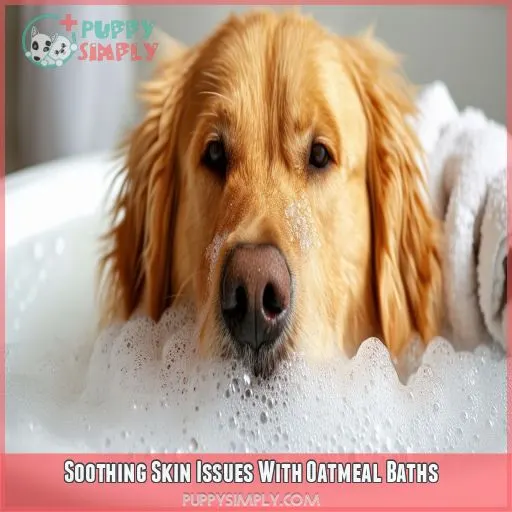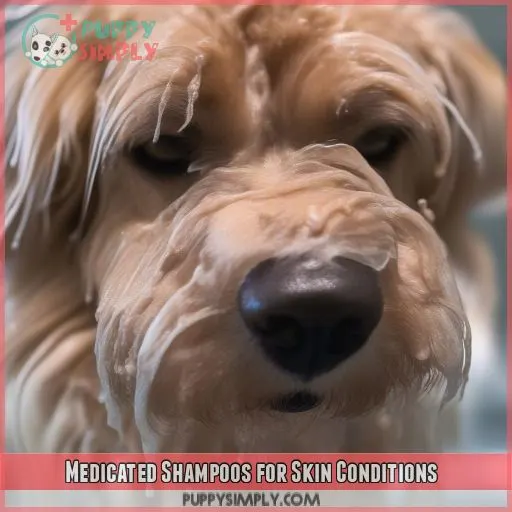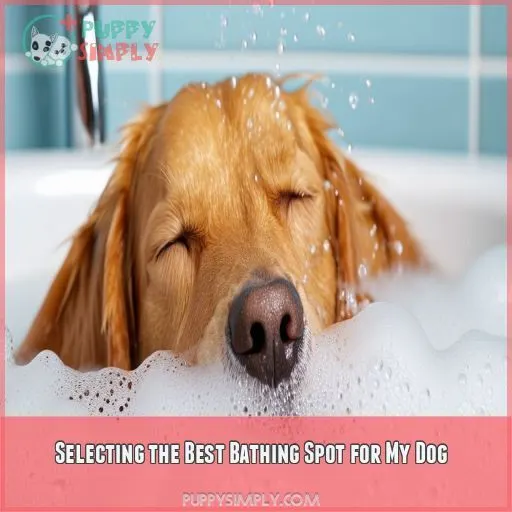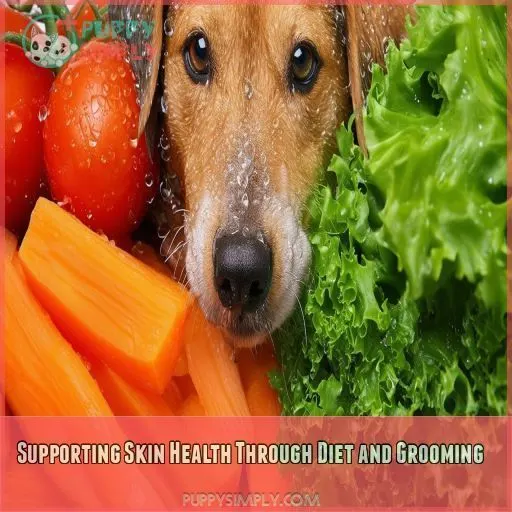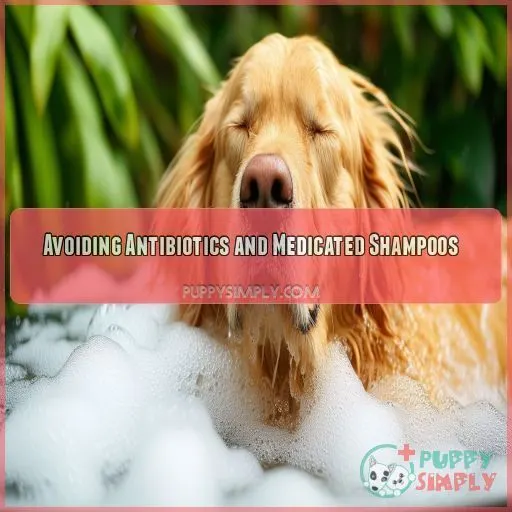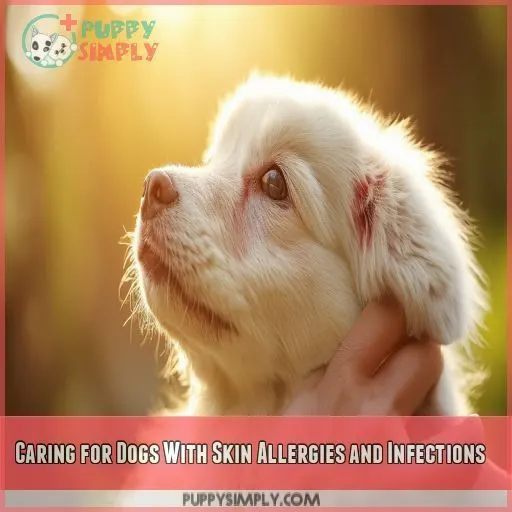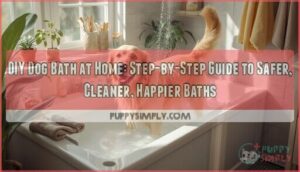This site is supported by our readers. We may earn a commission, at no cost to you, if you purchase through links.

oatmeal baths are a go-to option, thanks to oatmeal’s anti-inflammatory properties that soothe itchy, dry skin.
For more severe cases, medicated shampoos treat specific skin conditions, but choose these carefully with your vet’s guidance.
When it comes to dog washing, pick a suitable spot with easy access to warm water and clean, dry towels.
The right location depends on your dog’s size—bathtubs for larger dogs, sinks for smaller pups.
Now, let’s break down the details of dog washing and bathing for skin conditions.
Table Of Contents
- Key Takeaways
- Soothing Skin Issues With Oatmeal Baths
- Medicated Shampoos for Skin Conditions
- Selecting the Best Bathing Spot for My Dog
- Understanding Canine Skin Health
- Supporting Skin Health Through Diet and Grooming
- Avoiding Antibiotics and Medicated Shampoos
- Caring for Dogs With Skin Allergies and Infections
- Frequently Asked Questions (FAQs)
- How to bathe a dog with a skin infection?
- What is the best thing to wash a dog with skin allergies?
- How to bathe a dog with very sensitive skin?
- How often should a dog with skin allergies be bathed?
- How often should I bathe my dog?
- Can I use human shampoo on my dog?
- Is oatmeal safe for dogs to eat?
- What are the signs of skin allergies in dogs?
- How do I know if my dog has a skin infection?
- Conclusion
Key Takeaways
- Soothing baths: Oatmeal baths are an effective way to provide relief for your dog’s itchy, dry skin. With anti-inflammatory properties, oatmeal calms irritated skin and acts as a protective barrier, locking in moisture.
- Medicated shampoos: For more severe skin conditions, medicated shampoos are a powerful tool. These are specialized treatments recommended by vets to tackle specific issues like bacterial and yeast infections, and skin allergies.
- Natural defenses: A holistic approach to grooming and diet is key. Focus on maintaining a healthy skin microbiome, including good bacteria, and nourish your dog’s skin with healthy fats, probiotics, and brewer’s yeast.
- Stress-free bathing: Choosing the right spot for bathing is essential. Opt for a bathtub, sink, or outdoor space, depending on your dog’s size, with warm water and easy access to clean, dry towels.
Soothing Skin Issues With Oatmeal Baths
If your furry friend is dealing with itchy, dry skin, you might be wondering how to help them find relief. Oatmeal baths can be a soothing solution for dogs dealing with minor skin irritations and itching.
Benefits of Oatmeal Baths for Dogs
Oatmeal baths are a great way to soothe your dog’s itchy, dry skin and provide some much-needed relief. They offer the following benefits:
- Anti-Inflammatory Properties: Oatmeal’s anti-inflammatory properties help calm irritated skin, providing welcome relief from itching.
- Skin Protection: Oatmeal acts as a protective barrier, locking in moisture and preventing dryness.
- Safe and Easy: Oatmeal baths are generally safe for dogs and easy to prepare with readily available ingredients.
- Cost-Effective: Oatmeal baths are a budget-friendly option to alleviate your dog’s skin discomfort.
What Ingredients Do I Need for an Oatmeal Bath?
So, you’re looking for ways to soothe your pup’s itchy skin with an oatmeal bath? You’re in the right place! The key ingredient, of course, is oatmeal. But not just any oatmeal will do. Here’s a quick breakdown of what you’ll need:
| Type of Oatmeal | Examples | Other Ingredients |
|---|---|---|
| Plain, Unflavored Oatmeal | Slow-cooking, instant, or quick oats | Food processor/blender/coffee grinder, warm water, optional oils or milk |
Be sure to use plain oatmeal, as flavored varieties may contain ingredients that could irritate your dog’s skin. You’ll also need a way to grind the oats into a fine powder, hence the food processor, blender, or coffee grinder. Warm water is important to avoid drying out your pup’s skin, and you can optionally add oils or milk for extra moisture.
Preparing the Oatmeal Bath for My Dog
Preparing an oatmeal bath for your dog is simple.
First, grind the oats into a fine powder using a food processor, blender, or coffee grinder.
Next, stir a tablespoon of the powder into warm water and check the consistency.
The water should be milky and smooth, indicating that the oats are ground finely enough.
If not, just give them another whirl in the grinder and test again.
Easy!
Giving My Dog an Oatmeal Bath
Now that you’ve prepared the oatmeal bath, it’s time to give your furry friend a soothing soak. Here’s a step-by-step guide:
- Fill the tub with warm water to a comfortable level for your dog.
- Add the oatmeal powder you prepared earlier and stir it into the water until it’s evenly mixed.
- Let your dog soak in the tub for about 10 minutes. During this time, gently massage the oatmeal mixture into their skin. This helps make sure the oatmeal’s benefits reach every inch of their coat.
- After the soak, thoroughly rinse the oatmeal mixture off with warm water. You don’t want any residue left behind!
- Gently dry your dog with a towel. If they’re comfortable with it, you can also use a hairdryer on a low setting to speed up the drying process.
Medicated Shampoos for Skin Conditions
If your furry friend is dealing with a skin condition, medicated shampoos can be a powerful tool. These shampoos are specifically recommended by vets to tackle a range of skin issues, from bacterial and yeast infections to skin allergies. Let’s take a closer look at when and how to use these shampoos to help your dog feel better.
When to Use Medicated Shampoos
Medicated shampoos are your go-to for tackling specific skin conditions in your furry friend. These aren’t your everyday shampoos, but specialized treatments recommended by vets to address particular issues.
So, when should you reach for the medicated shampoo bottle? Here are some common scenarios:
- Bacterial Skin Infections: These bad boys can be treated with antibacterial shampoo, sometimes alongside a course of oral antibiotics prescribed by your vet.
- Yeast Infections: No fun for your pup, but a common issue. Antifungal shampoo is often the treatment of choice here.
- Skin Allergies: If your doggo’s skin is feeling the itch, medicated shampoos can be a lifesaver. They help reduce inflammation, soothe itching, and keep allergens at bay.
Choosing the Right Medicated Shampoo
Choosing the right medicated shampoo for your dog’s skin condition is really important. Here are some things to keep in mind:
- Vet-approved: Always opt for shampoos that are veterinarian-recommended or prescribed. These shampoos are specifically formulated to treat various skin ailments in dogs.
- Shampoo types: Different types of medicated shampoos target specific issues. For instance, antibacterial shampoos tackle bacterial skin infections, while antifungal shampoos address yeast infections.
- Skin concerns: Consider your dog’s unique skin concerns. If they’ve allergies, look for shampoos that reduce inflammation and itching.
- Dog allergies: Some dogs may be allergic to certain ingredients in shampoos. Watch for any signs of allergic reactions.
- Brand reviews: Research and read reviews of different brands. Look for brands that are trusted by vets and have a good reputation.
Bathing Your Dog With Medicated Shampoo
Now that you’ve chosen the right medicated shampoo for your dog, it’s time to get started with the bath routine. Here’s a step-by-step guide to make sure things go smoothly and effectively:
- Thorough Pre-Rinse: Start by giving your dog a good rinse with lukewarm water. This will help wet their fur and get their skin ready for the medicated shampoo.
- Pre-Clean with Regular Shampoo (If Needed): If your pup is visibly dirty, use a mild, dog-safe shampoo to remove any dirt and debris first. This makes sure the medicated shampoo can do its job effectively.
- Focus on Affected Areas First: Work the medicated shampoo into their coat, starting with the most affected areas like their paws, armpits, groin, and the area around the rectum.
- Massage Throughout the Rest of the Body: Continue massaging the shampoo into the coat across the rest of their body. Follow the instructions on the bottle or your vet’s advice for the right amount to use.
- Set a Timer for Contact Time: After lathering, set a timer for the recommended contact time, usually around 10 minutes, as advised by your veterinarian.
Frequency and Expectations for Medicated Baths
The frequency of medicated baths for your dog will depend on a few factors, primarily the specific skin condition being treated. Here’s what you need to know about how often to give your dog a medicated bath and what to expect:
- Weekly baths are common for many skin conditions, but this may vary depending on the issue.
- Your veterinarian is the best source of guidance on bathing frequency. They’ll advise you on how often to bathe your dog based on their specific condition.
- You should start seeing improvements in your dog’s skin within the first few weeks of using the medicated shampoo.
- Your veterinarian can give you a more precise timeline for when to expect improvements, specific to your dog’s condition.
Selecting the Best Bathing Spot for My Dog
Choosing the right spot to bathe your dog is really important for a stress-free experience. You can opt for a bathtub, sink, or even outdoor bathing, depending on your dog’s size and the weather.
Options for Bathing Your Dog at Home
You’ve got a few options for bathing your dog at home, depending on their size and your setup:
- Bathtub: This is a go-to for many dog owners, especially for larger dogs who mightn’t fit in a sink.
- Sink, kitchen, or utility room: These spots can work well for smaller dogs.
- Warm and accessible: Wherever you bathe your dog, make sure you have warm water and easy access to clean, dry towels.
Outdoor Bathing for Large Dogs
If you’ve got a big pooch, bathing them outdoors can be a great option, especially in warm weather. Just make sure you choose a well-drained area to avoid creating a muddy mess.
This option gives your dog plenty of space to move around and shake off that excess water. It’s also a good choice if your dog isn’t a fan of being confined to a tub.
Essential Equipment for a Stress-Free Bath
Choosing the right spot for your dog’s bath is key to a stress-free experience.
For larger dogs, a bathtub is a common choice. If you’ve got a smaller pup, a sink or utility room might be a better fit. In warmer weather, you could also try outdoor bathing for a change of scenery.
Make sure the spot has warm water and easy access to clean, dry towels. A spray nozzle or hose attachment can also make rinsing a breeze.
Understanding Canine Skin Health
Did you know that your dog’s skin is a powerhouse, with each layer serving a unique purpose? From electrolyte balance to immune defense, understanding the ins and outs of your furry friend’s skin health is key to keeping them in tip-top shape.
The Three Layers of Skin and Their Functions
Your dog’s skin, just like yours, is made up of three layers, each with its own important role:
- Subcutis: Think of this as your dog’s built-in reservoir, storing electrolytes, fluids, and energy.
- Dermis: This layer is a busy hub, containing nerves, blood vessels, hair follicles, and immune cells.
- Epidermis: The outermost layer is your dog’s first line of defense, protecting against foreign substances and pathogens.
Maintaining Skin Health Through Diet and Grooming
You can support your dog’s skin health through their diet and grooming habits.
A high-protein diet with quality meat and organ cuts is key for a healthy coat and skin. Include healthy fats for skin function and consider adding probiotics and brewer’s yeast to their meals.
If you do wash your dog, use water baths without shampoo to avoid stripping away natural oils.
After bath time, use enzyme and probiotic skin and coat sprays to restore balance to their skin microbiome.
The Negative Effects of Overbathing on Skin Health
Overbathing your pup? You could be stripping away their natural defenses, leaving them vulnerable to skin issues. Here’s the lowdown on why overbathing does more harm than good.
First off, overbathing washes away sebum, that natural oil that keeps your dog’s skin moist and healthy. Without enough sebum, your pup’s skin dries out, becoming brittle and more prone to infections.
And there’s more. Over time, frequent baths can make your dog’s skin thicker and less flexible, thanks to increased keratinocyte production. Not ideal when you want your furry friend’s skin to be supple and resilient.
But wait, there’s a final blow. Overbathing wipes out the good bacteria that protect your dog’s skin from harmful pathogens. Without this natural defense, your dog’s skin is left exposed to potential invaders.
Supporting Skin Health Through Diet and Grooming
Just like us, dogs need a healthy diet and grooming routine to keep their skin in tip-top shape. Let’s take a closer look at how you can support your furry friend’s skin health through nutrition and grooming habits.
Nourishing Skin and Coat Through Diet
Want to give your dog a healthy coat and skin? A few key things in their diet can make a big difference:
- High-quality protein: Make sure your dog’s diet includes quality meat and organ cuts.
- Healthy fats: Support the subcutis layer and overall skin function with omega-3s, olive oil, or avocado oil.
Probiotics and Brewer’s Yeast for Skin Health
Probiotics and brewer’s yeast are your dynamic duo for boosting your pup’s skin health. These supplements are like a spa treatment for your dog’s gut, promoting a healthy balance of bacteria that reflects on their skin and coat. Think of it like watering a garden to make those flowers flourish!
Probiotics are the good bacteria that give your dog’s immune system a helping hand, while brewer’s yeast adds a punch of B vitamins and minerals. Together, they’re a recipe for healthy skin, supporting your dog’s natural defenses and keeping their coat glossy.
But wait, there’s more! Probiotics also help ward off yeast infections, which can cause localized itch and discomfort. It’s like an internal spa treatment with external benefits.
Enzyme and Probiotic Skin and Coat Sprays
Misting your dog with enzyme and probiotic skin and coat sprays can be a game-changer for their skin health.
These sprays help restore the good bacteria and balance the microbiome on your dog’s skin and coat.
This misting step is especially beneficial after a shampoo bath, which can strip away beneficial bacteria.
Avoiding Antibiotics and Medicated Shampoos
You might be tempted to reach for medicated shampoos or antibiotics to treat your dog’s skin issues. But hold up – these can do more harm than good. Medicated shampoos can wreck your dog’s skin microbiome and damage their Langerhans cells. Antibiotics? They mess with the skin’s microbiome too, leaving your pup vulnerable to infections.
The Dangers of Antibiotics for Skin Health
Antibiotics can have some unintended consequences for your dog’s skin health. Here’s why you should think twice before reaching for those pills:
- Antibiotics disrupt the delicate balance of bacteria on your dog’s skin, making it more vulnerable to infection.
- They can create a vicious cycle where you end up overbathing your dog to address skin problems caused by the antibiotics themselves.
- Antibiotics don’t discriminate between good and bad bacteria, so they wipe out the beneficial bacteria that protect your dog’s skin.
- These drugs can also interfere with the natural functions of your dog’s skin, like sebum production, which keeps the skin and coat healthy.
- Prolonged use of antibiotics may lead to antibiotic resistance, making future infections harder to treat.
Why Medicated Shampoos Can Harm Skin
Medicated shampoos can also wreak havoc on your dog’s skin microbiome, damaging the Langerhans cells responsible for capturing bacteria and triggering immune responses. This leaves your dog’s skin vulnerable to pathogens and infections. It’s a double whammy of trouble.
Focusing on Natural Skin Defenses
A holistic approach to grooming and diet is key to supporting your dog’s skin health. Instead of relying on medicated shampoos and antibiotics, which can damage the skin’s natural defenses, focus on these strategies:
- Microbiome Maintenance: The skin’s microbiome is vital for overall health. Use enzyme and probiotic skin sprays post-bath to restore balance.
- Dietary Adjustments: Nourish your dog’s skin from within. Include healthy fats and consider adding probiotics and brewer’s yeast to their meals.
- Gentle Grooming: Opt for water baths without shampoo to remove dirt without stripping away protective sebum.
Caring for Dogs With Skin Allergies and Infections
If your furry friend is dealing with skin allergies or infections, you’re probably wondering how to help them find relief. Well, you’re in the right place.
How to Bathe a Dog With Skin Allergies
Start by choosing a bathing spot that’s warm and accessible, with easy access to clean, dry towels.
Fill the tub with warm water and use a shampoo specifically formulated for dogs with skin allergies. You can also ask your veterinarian for recommendations.
Gently massage the shampoo into your dog’s coat, paying extra attention to affected areas like their paws, armpits, and groin.
Set a timer for 10 minutes before thoroughly rinsing off all the shampoo.
What to Wash a Dog With Skin Infections
If your dog has a skin infection, you’ll want to reach for medicated shampoos, prescribed by your veterinarian, to treat the issue. These medicated shampoos are designed to combat bacterial skin infections, yeast infections, and skin allergies. Antibacterial shampoos, for example, are often used in conjunction with oral antibiotics to tackle bacterial skin infections.
How Often to Bathe a Dog With Skin Issues
If you’re dealing with a dog who’s skin allergies or infections, figuring out how often to bathe them can be tricky. Here’s a guide to help you:
- Veterinarian Guidance: Your vet is the best person to talk to about how often to bathe your dog. They’ll consider the specific problem, how bad it is, and your dog’s overall health to give you a bathing schedule that works.
- Weekly Baths: Generally, weekly baths are common for dogs with skin issues. This keeps things clean and helps manage symptoms without going overboard.
- Adjust as Needed: Keep a close eye on your dog’s skin and how they’re doing. If their skin looks worse, call your vet right away. They might suggest changing how often you bathe them or trying something different.
Frequently Asked Questions (FAQs)
How to bathe a dog with a skin infection?
If your dog has a skin infection, it’s important to get advice from your vet. They may recommend a medicated shampoo. You’ll need to give your dog a thorough pre-rinse, and focus on working the shampoo into affected areas.
What is the best thing to wash a dog with skin allergies?
Is your furry friend itching for relief? Try an oatmeal bath or a soapless, hypoallergenic shampoo. You can make a DIY blend with oats and water or buy a vet-approved option.
How to bathe a dog with very sensitive skin?
For a dog with sensitive skin, try an oatmeal bath. It’s easy to prepare, safe, and soothes minor skin irritations. You can add oils or milk for extra moisture.
How often should a dog with skin allergies be bathed?
You’ll want to give your dog a bath about once a week. But it’s best to ask your vet, since they’ll give you a timeline based on your dog’s specific condition.
How often should I bathe my dog?
How often you bathe your dog depends on their fur type, lifestyle, and overall health. Generally, once a month is enough for most dogs, but you can adjust this based on their unique needs.
Can I use human shampoo on my dog?
No, human shampoo isn’t suitable for dogs. It can alter their skin pH, causing dryness, flaking, and infection. Human shampoo is also harder to rinse out and can irritate your dog’s skin if not fully washed out.
Is oatmeal safe for dogs to eat?
Plain, cooked oatmeal is generally safe for dogs to eat. But steer clear of oatmeal with added sugars, salt, and dangerous ingredients like xylitol, raisins, and chocolate.
What are the signs of skin allergies in dogs?
What’s causing that itch? Skin allergies in dogs can manifest as itchy, red, irritated, or flaky skin. You might also notice your dog scooting, rubbing its face, or chewing its skin.
How do I know if my dog has a skin infection?
Keep an eye out for symptoms like redness, swelling, discharge, hair loss, and odour. If you spot any of these, it’s best to get your pup to the vet for a proper diagnosis.
Conclusion
You’re now equipped with the know-how to tackle dog washing and bathing for skin conditions.
You can soothe your furry friend’s skin woes with oatmeal baths and medicated shampoos, choosing the right location for a stress-free experience.
Understanding your dog’s skin health, and supporting it through diet and grooming, is key to keeping their coat healthy and shiny.
By taking a natural approach and focusing on skin defences, you can avoid the potential pitfalls of antibiotics and medicated shampoos.

